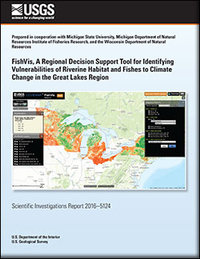FishVis, A regional decision support tool for identifying vulnerabilities of riverine habitat and fishes to climate change in the Great Lakes Region
Links
- Document: Report (2.51 MB pdf)
- Appendix: Appendixes 1–4 (34.4 kB xlsx)
- Data Release: USGS data release - FishVis, predicted occurrence and vulnerability for 13 fish species for current (1961 - 1990) and future (2046 - 2100) climate conditions in Great Lakes streams.
- Download citation as: RIS | Dublin Core
Abstract
Climate change is expected to alter the distributions and community composition of stream fishes in the Great Lakes region in the 21st century, in part as a result of altered hydrological systems (stream temperature, streamflow, and habitat). Resource managers need information and tools to understand where fish species and stream habitats are expected to change under future conditions. Fish sample collections and environmental variables from multiple sources across the United States Great Lakes Basin were integrated and used to develop empirical models to predict fish species occurrence under present-day climate conditions. Random Forests models were used to predict the probability of occurrence of 13 lotic fish species within each stream reach in the study area. Downscaled climate data from general circulation models were integrated with the fish species occurrence models to project fish species occurrence under future climate conditions. The 13 fish species represented three ecological guilds associated with water temperature (cold, cool, and warm), and the species were distributed in streams across the Great Lakes region. Vulnerability (loss of species) and opportunity (gain of species) scores were calculated for all stream reaches by evaluating changes in fish species occurrence from present-day to future climate conditions. The 13 fish species included 4 cold-water species, 5 cool-water species, and 4 warm-water species. Presently, the 4 cold-water species occupy from 15 percent (55,000 kilometers [km]) to 35 percent (130,000 km) of the total stream length (369,215 km) across the study area; the 5 cool-water species, from 9 percent (33,000 km) to 58 percent (215,000 km); and the 4 warm-water species, from 9 percent (33,000 km) to 38 percent (141,000 km).
Fish models linked to projections from 13 downscaled climate models projected that in the mid to late 21st century (2046–65 and 2081–2100, respectively) habitats suitable for all 4 cold-water species and 4 of 5 cool-water species under present-day conditions will decline as much as 86 percent and as little as 33 percent, and habitats suitable for all 4 warm-water species will increase as much as 33 percent and as little as 7 percent. This report documents the approach and data used to predict and project fish species occurrence under present-day and future climate conditions for 13 lotic fish species in the United States Great Lakes Basin. A Web-based decision support mapping application termed “FishVis” was developed to provide a means to integrate, visualize, query, and download the results of these projected climate-driven responses and help inform conservation planning efforts within the region.
Suggested Citation
Stewart, J.S., Covert, S.A., Estes, N.J., Westenbroek, S.M., Krueger, Damon, Wieferich, D.J., Slattery, M.T., Lyons, J.D., McKenna, J.E., Jr., Infante, D.M., and Bruce, J.L., 2016, FishVis, A regional decision support tool for identifying vulnerabilities of riverine habitat and fishes to climate change in the Great Lakes Region: U.S. Geological Survey Scientific Investigations Report 2016–5124, 15 p., with appendixes, https://dx.doi.org/10.3133/sir20165124.
ISSN: 2328-0328 (online)
Study Area
Table of Contents
- Acknowledgments
- Abstract
- Introduction
- Methods
- Fish Species Occurrence Under Current and Future Climate Conditions
- FishVis, A Web-Based Decision Support Mapping Application
- Summary
- References Cited
- Appendixes 1–4
| Publication type | Report |
|---|---|
| Publication Subtype | USGS Numbered Series |
| Title | FishVis, A regional decision support tool for identifying vulnerabilities of riverine habitat and fishes to climate change in the Great Lakes Region |
| Series title | Scientific Investigations Report |
| Series number | 2016-5124 |
| DOI | 10.3133/sir20165124 |
| Publication Date | October 13, 2016 |
| Year Published | 2016 |
| Language | English |
| Publisher | U.S. Geological Survey |
| Publisher location | Reston, VA |
| Contributing office(s) | Wisconsin Water Science Center, Core Science Analytics, Synthesis, and Libraries |
| Description | Report: viii, 15 p.; Appendixes 1-4 |
| Country | United States |
| Other Geospatial | Great Lakes Region |
| Online Only (Y/N) | Y |
| Additional Online Files (Y/N) | Y |


